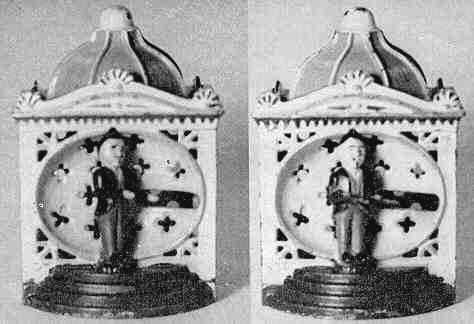Hall’s Liliput
by F.H. Griffith - HOBBIES Magazine - January, 1980

John Hall was one of the pioneer designers of mechanical banks and for the most part he had a definite thing about the way a bank should work, and this was by the weight of a coin. That is to say, the weight caused the action of the parts involved when the coin was set in place or deposited in the bank. Hall was active in the 1870’s, which is the earliest period of mechanical banks. His banks were made by the J. & E. Stevens Company of Cromwell, Connecticut.
Hall’s mechanicals, as designed by him, are not particularly spectacular as to action, but the idea of the necessity of using a coin, plus the weight factor, are very desirable features. Then, too, his banks are quite attractive and proportionate. They are well designed, well made, and could stand usage without getting out of order.
The Liliput, Type II and Type III, well represent Hall’s work and they are chosen as No. 284 and 285 respectively in our numerical classification.
The Hall’s Liliput, Type II (Photo Figure 1), is basically the same as Type III except there is no tray in the man’s hands and the figures are somewhat different. The buildings are alike in size and construction and they have wording on the sides and back of the building, which is unusual.
The Type II is somewhat earlier than the Type III, since after the Type III was put into production all Liliputs from then on had a tray in the teller’s hands. On the left side of the Type II building appears the wording ‘HALL’S LILIPUT BANK’ in red letters. The back shows ‘PAT DESIGN JULY 27, 1875’. The right side ‘PATENTED MAY 1875’ in red letters.
The bank shown in Figure 1 is in great original condition with excellent paint in following colors: The building is yellow with a dome in red, top knob in white, and lines of the dome in white. Decorations on the front of the building are in blue and red and the steps are dark brown. The sunken oval section in back of the teller is a light blue green. The figure has a black jacket, gray trousers, black shoes, red vest, and white shirt. His face and hands are flesh color and his features and hair are black.
To operate, a penny is placed on the extended forearms of the teller. The weight of the penny causes the figure to turn to his left and the coin is deposited in the provided slot. The teller is tilted somewhat and balanced so that he returns to position for another coin.
Type III (Photo Figure 2) has a tray in his hands and thus the arms of the figure are considerably shorter than the forearms of the Type II. This bank is also in pristine condition with wording and color the same as Type II. The round tray in the teller’s hands is crinkled on the outer edge which enables a coin to slide from the tray more easily. The operation of this bank is the same as Type II.
The banks make an exceptional pair to have in a collection. They are good examples of Hall’s designing talents, and the Type II is a challenge to obtain — it’s not very easy to come by.
